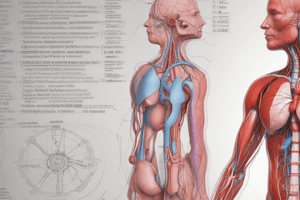Podcast
Questions and Answers
Because the collapse of a vein following coronary artery bypass surgery may occur, a significant concern in the care of these patients postoperatively is a blood pressure reading below normal or
Because the collapse of a vein following coronary artery bypass surgery may occur, a significant concern in the care of these patients postoperatively is a blood pressure reading below normal or
- hypothermia.
- hypotension. (correct)
- hypertension.
- hypertriglyceridemia.
The term anemia is defined as
The term anemia is defined as
- an excessive increase in abnormal leukocytes.
- condition in which pathogenic microorganisms enter the bloodstream.
- condition in which there is a reduction in the number of erythrocytes. (correct)
- the dissolution of erythrocytes.
An injection of a medication either intravenously or intraarterially to dissolve blood clots is called
An injection of a medication either intravenously or intraarterially to dissolve blood clots is called
- plasmapheresis.
- coronary stent.
- thrombolytic therapy. (correct)
- catheter ablation.
The procedure used to puncture a vein with a needle to remove blood, instill a medication, or start an intravenous infusion is
The procedure used to puncture a vein with a needle to remove blood, instill a medication, or start an intravenous infusion is
The suffix that means excessive flow is
The suffix that means excessive flow is
Chest pain that occurs when there is an insufficient supply of blood to the heart muscle is called
Chest pain that occurs when there is an insufficient supply of blood to the heart muscle is called
The term cardiology means
The term cardiology means
Following illness with rheumatic fever, the child began showing signs of narrowing of the mitral valve from scarring or
Following illness with rheumatic fever, the child began showing signs of narrowing of the mitral valve from scarring or
The prefix pan- means
The prefix pan- means
A record of the electrical activity of the heart is called a(n)
A record of the electrical activity of the heart is called a(n)
The professional who operates the heart-lung machine during surgeries where the patient's blood must be oxygenated outside of the body is called a
The professional who operates the heart-lung machine during surgeries where the patient's blood must be oxygenated outside of the body is called a
The abbreviation for sudden symptoms of insufficient blood supply to the heart is
The abbreviation for sudden symptoms of insufficient blood supply to the heart is
The inability of the heart to pump enough blood through the body to supply the tissues and organs is called
The inability of the heart to pump enough blood through the body to supply the tissues and organs is called
The term hemostasis is defined as the
The term hemostasis is defined as the
Lymphangiography is the
Lymphangiography is the
The combining form that refers to the body system that protects against pathogens, but does not have its own organs and structure is
The combining form that refers to the body system that protects against pathogens, but does not have its own organs and structure is
The term blood dyscrasia is defined as
The term blood dyscrasia is defined as
Which of the following is also called a heart attack?
Which of the following is also called a heart attack?
The procedure in which a balloon is advanced into a blood vessel to the area in which the plaque has formed is called
The procedure in which a balloon is advanced into a blood vessel to the area in which the plaque has formed is called
The term that means surgical puncture to aspirate fluid from the sac surrounding the heart is
The term that means surgical puncture to aspirate fluid from the sac surrounding the heart is
Because of one completely and two partially obstructed arteries, the patient was scheduled for surgery to bring a new blood supply to the heart muscle by detouring around the obstructed arteries called
Because of one completely and two partially obstructed arteries, the patient was scheduled for surgery to bring a new blood supply to the heart muscle by detouring around the obstructed arteries called
The term that means removal of the liquid portion of the blood (from withdrawn blood) is
The term that means removal of the liquid portion of the blood (from withdrawn blood) is
The combining form embol/o is defined as
The combining form embol/o is defined as
An exaggerated life-threatening reaction to a previously encountered antigen is called
An exaggerated life-threatening reaction to a previously encountered antigen is called
The abbreviation INR, meaning international normalized ratio, is used to provide uniform results for which test?
The abbreviation INR, meaning international normalized ratio, is used to provide uniform results for which test?
Flashcards
Cardiovascular System
Cardiovascular System
The system that circulates blood through the body, consisting of the heart, blood vessels, and blood.
Blood Vessels
Blood Vessels
Tubular structures that carry blood throughout the body, including arteries, veins, and capillaries.
Arteries
Arteries
Blood vessels that carry oxygen-rich blood away from the heart to the body.
Veins
Veins
Signup and view all the flashcards
Capillaries
Capillaries
Signup and view all the flashcards
Heart
Heart
Signup and view all the flashcards
Red Blood Cells (RBCs)
Red Blood Cells (RBCs)
Signup and view all the flashcards
White Blood Cells (WBCs)
White Blood Cells (WBCs)
Signup and view all the flashcards
Platelets
Platelets
Signup and view all the flashcards
Blood Pressure
Blood Pressure
Signup and view all the flashcards
Lymphatic System
Lymphatic System
Signup and view all the flashcards
Lymph
Lymph
Signup and view all the flashcards
Immune System
Immune System
Signup and view all the flashcards
Antibodies
Antibodies
Signup and view all the flashcards
Infection
Infection
Signup and view all the flashcards
Vaccine
Vaccine
Signup and view all the flashcards
Blood Clotting
Blood Clotting
Signup and view all the flashcards
Heart Rate
Heart Rate
Signup and view all the flashcards
Cholesterol
Cholesterol
Signup and view all the flashcards
Atherosclerosis
Atherosclerosis
Signup and view all the flashcards
Hypertension
Hypertension
Signup and view all the flashcards
Arrhythmia
Arrhythmia
Signup and view all the flashcards
Stroke
Stroke
Signup and view all the flashcards
Hemoglobin
Hemoglobin
Signup and view all the flashcards
Anemia
Anemia
Signup and view all the flashcards
Spleen
Spleen
Signup and view all the flashcards
Thymus
Thymus
Signup and view all the flashcards
Bone Marrow
Bone Marrow
Signup and view all the flashcards
Lymph Nodes
Lymph Nodes
Signup and view all the flashcards
Study Notes
Cardiovascular, Immune, and Lymphatic System and Blood Quiz Notes
- Hypotension: A significant concern post-coronary artery bypass surgery, blood pressure below normal.
- Anemia: Defined as a condition with a reduction in the number of red blood cells (erythrocytes).
- Thrombolytic Therapy: Medication injection (intravenously or intra-arterially) to dissolve blood clots.
- Venipuncture: Procedure for puncturing a vein to collect blood, administer medication, or insert intravenous fluids.
- -rrhage: Suffix meaning excessive flow.
- Angina Pectoris: Chest pain due to insufficient blood supply to the heart muscle.
- Cardiology: Study of the heart.
- Mitral Valve Stenosis: Narrowing of the mitral valve, often following rheumatic fever.
- Electrocardiogram (ECG/EKG): Recording of the electrical activity of the heart.
- Perfusionist: Professional operating heart-lung machines during surgeries where blood is oxygenated outside the body.
- Acute Coronary Syndrome (ACS): Sudden symptoms of insufficient blood supply to the heart.
- Heart Failure: Inability of the heart to pump enough blood to supply tissues and organs.
- Hemostasis: Stoppage of bleeding.
- Lymphangiography: Radiographic imaging of lymph vessels.
- Immunology: Study of the immune system which protects against pathogens.
- Blood Dyscrasia: Any pathological condition of the blood.
- Myocardial Infarction (MI): Heart attack. This is also called a coronary artery disease (CAD)
- Percutaneous Transluminal Coronary Angioplasty (PTCA): Procedure to open blocked coronary arteries by inserting a balloon into the artery in a narrowed area.
- Pericardiocentesis: Surgical puncture to aspirate fluid from the sac surrounding the heart.
- Congenital heart disease: Inherited heart problems which present themselves through obstructed blood vessels in the heart.
- CABG (Coronary Artery Bypass Graft): Surgical procedure to bring a new blood supply to the heart by rerouting blood around blocked arteries.
- Plasmapheresis: Removal of the liquid portion (plasma) of the blood.
- Embolus: Bloody clot that travels or travels loose in the blood vessels.
- Anaphylaxis: Life-threatening reaction to a previously encountered antigen.
- INR (International Normalized Ratio): Standardized results for the prothrombin time (PT) blood test.
Studying That Suits You
Use AI to generate personalized quizzes and flashcards to suit your learning preferences.
Description
Quiz about cardiovascular system, immune system and blood. Covers topics such as hypotension, anemia, thrombolytic therapy, cardiology, and other conditions related to blood and the heart. Also includes medical procedures in this area.




